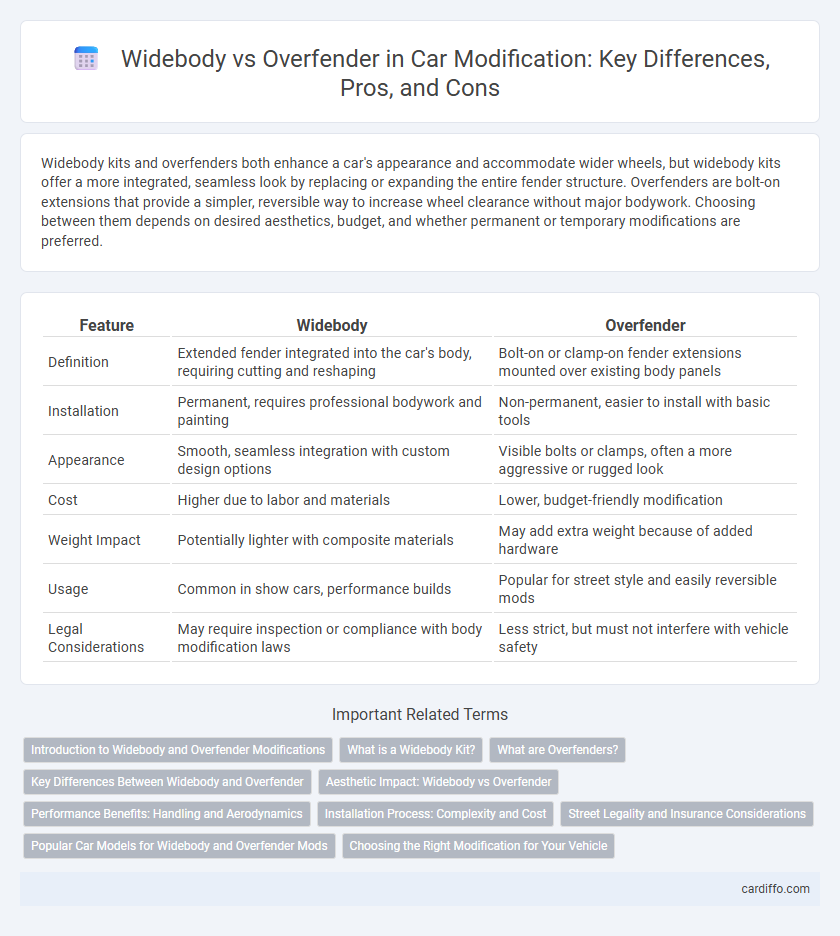Widebody kits and overfenders both enhance a car's appearance and accommodate wider wheels, but widebody kits offer a more integrated, seamless look by replacing or expanding the entire fender structure. Overfenders are bolt-on extensions that provide a simpler, reversible way to increase wheel clearance without major bodywork. Choosing between them depends on desired aesthetics, budget, and whether permanent or temporary modifications are preferred.
Table of Comparison
| Feature | Widebody | Overfender |
|---|---|---|
| Definition | Extended fender integrated into the car's body, requiring cutting and reshaping | Bolt-on or clamp-on fender extensions mounted over existing body panels |
| Installation | Permanent, requires professional bodywork and painting | Non-permanent, easier to install with basic tools |
| Appearance | Smooth, seamless integration with custom design options | Visible bolts or clamps, often a more aggressive or rugged look |
| Cost | Higher due to labor and materials | Lower, budget-friendly modification |
| Weight Impact | Potentially lighter with composite materials | May add extra weight because of added hardware |
| Usage | Common in show cars, performance builds | Popular for street style and easily reversible mods |
| Legal Considerations | May require inspection or compliance with body modification laws | Less strict, but must not interfere with vehicle safety |
Introduction to Widebody and Overfender Modifications
Widebody modifications involve permanently widening the vehicle's fenders by cutting and reshaping the body panels to accommodate larger wheels and tires, enhancing both aesthetics and performance. Overfenders are bolt-on or riveted extensions that increase the width of the fenders without altering the original body structure, offering a reversible and less invasive modification option. Both techniques improve wheel fitment and stance, with widebodies providing a seamless integration and overfenders allowing easier customization and adjustment.
What is a Widebody Kit?
A widebody kit is an automotive modification that expands a vehicle's wheel arches by replacing or extending the fenders to accommodate wider tires and improve aerodynamics. Unlike overfenders, which are bolt-on extensions placed over the existing fenders, widebody kits typically involve cutting and reshaping the original panels for a seamless, integrated look. This modification enhances the car's stance and handling by allowing for increased track width and tire clearance.
What are Overfenders?
Overfenders are aftermarket car accessories designed to extend the width of a vehicle's wheel arches, allowing for wider wheels and tires without altering the factory body. Unlike widebody kits that require cutting and reshaping the vehicle's panels, overfenders bolt onto the existing fenders, providing a simpler and reversible modification. These components enhance the car's stance and handling while offering a more aggressive appearance with less permanent body modification.
Key Differences Between Widebody and Overfender
Widebody modifications involve replacing or significantly altering the vehicle's entire fender and quarter panel to achieve a wider stance, while overfenders are bolt-on or weld-on extensions that overlay the original fender for increased width. Widebody kits typically require cutting and reshaping metal, offering a flush and integrated look, whereas overfenders preserve the stock bodywork beneath, providing a reversible enhancement. Widebodies are favored for aggressive styling and improved aerodynamics, while overfenders offer a simpler installation and are often used to cover wider tires without major structural changes.
Aesthetic Impact: Widebody vs Overfender
Widebody kits provide a seamless, aggressive aesthetic by integrating wider fenders directly into the car's body, creating a cohesive and bold stance. Overfenders are bolt-on or clip-on extensions that offer a distinct layered look, enhancing width without permanent modification, often appealing to enthusiasts seeking reversible changes. Both styles dramatically increase the vehicle's visual presence but differ in the level of bodywork integration and overall design fluidity.
Performance Benefits: Handling and Aerodynamics
Widebody kits enhance vehicle performance by increasing track width, resulting in improved handling stability and cornering grip during high-speed maneuvers. Overfenders, while primarily aesthetic, allow for wider tires but often lack integrated aerodynamic improvements found in widebody designs. The optimized airflow and reduced drag areas in widebody modifications contribute significantly to better downforce and overall vehicle dynamics on the track.
Installation Process: Complexity and Cost
Widebody kits require extensive modification, including cutting and reshaping the original fenders, which significantly increases both installation time and labor costs. Overfenders, on the other hand, are bolt-on additions that simplify installation and reduce expenses due to minimal alteration of the vehicle's body. The complexity and cost of widebody installations are notably higher compared to the straightforward application of overfenders.
Street Legality and Insurance Considerations
Widebody kits often require significant modifications to the vehicle's original structure, which can impact street legality depending on local regulations and necessitate thorough inspections. Overfenders typically bolt onto existing fenders, preserving the car's factory dimensions and maintaining compliance with street-legal standards more easily. Insurance providers may consider widebody modifications as higher risk, potentially increasing premiums, while overfenders usually present fewer issues for coverage due to their less invasive installation.
Popular Car Models for Widebody and Overfender Mods
Popular car models for widebody modifications include the Nissan GT-R R35, Toyota Supra MK4, and Ford Mustang, favored for their aggressive stance and improved aerodynamics. Overfender kits are commonly applied to vehicles like the Mazda RX-7 FD, Subaru WRX STI, and Honda Civic, offering a subtle yet effective increase in tire clearance and visual width. These modifications enhance both performance and aesthetics, tailoring each car to the owner's style and functional needs.
Choosing the Right Modification for Your Vehicle
Widebody kits significantly alter a vehicle's frame, extending the fenders to accommodate wider wheels and improved aerodynamics, ideal for those seeking aggressive styling and enhanced performance. Overfenders, on the other hand, add bolt-on extensions over existing fenders, offering easier installation and reversible customization without major structural changes. Consider the intended use, budget, and installation complexity when choosing between a widebody for a permanent, performance-focused upgrade or overfenders for a cost-effective, less invasive modification.
widebody vs overfender Infographic

 cardiffo.com
cardiffo.com